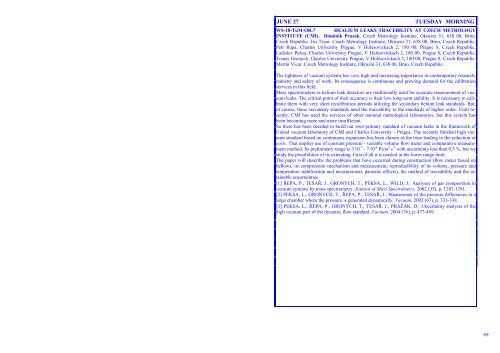Wüest M. 51 Wykes M. 82 Yamaguchi M. 17 Ybarra G. 129 Yubero F ...
Wüest M. 51 Wykes M. 82 Yamaguchi M. 17 Ybarra G. 129 Yubero F ...
Wüest M. 51 Wykes M. 82 Yamaguchi M. 17 Ybarra G. 129 Yubero F ...
You also want an ePaper? Increase the reach of your titles
YUMPU automatically turns print PDFs into web optimized ePapers that Google loves.
JUNE 27 TUESDAY MORNING<br />
WS-18-TuM-OR.7 HEALIUM LEAKS TRACEBILITY AT CZECH METROLOGY<br />
INSTITUTE (CMI). Dominik Prazak. Czech Metrology Institute, Okruzni 31, 638 00, Brno,<br />
Czech Republic. Jiri Tesar. Czech Metrology Institute, Okruzni 31, 638 00, Brno, Czech Republic.<br />
Petr Repa. Charles University Prague, V Holesovickach 2, 180 00, Prague 8, Czech Republic.<br />
Ladislav Peksa. Charles University Prague, V Holesovickach 2, 180 00, Prague 8, Czech Republic.<br />
Tomas Gronych. Charles University Prague, V Holesovickach 2, 180 00, Prague 8, Czech Republic.<br />
Martin Vicar. Czech Metrology Institute, Okruzni 31, 638 00, Brno, Czech Republic.<br />
The tightness of vacuum systems has very high and increasing importance in contemporary research,<br />
industry and safety of work. Its consequence is continuous and growing demand for the calibration<br />
services in this field.<br />
Mass spectrometers as helium leak detectors are traditionally used for accurate measurement of vacuum<br />
leaks. The critical point of their accuracy is their low long-term stability. It is necessary to calibrate<br />
them with very short recalibration periods utilizing the secondary helium leak standards. But,<br />
of course, these secondary standards need the traceability to the standards of higher order. Until recently,<br />
CMI has used the services of other national metrological laboratories, but this system has<br />
been becoming more and more insufficient.<br />
So there has been decided to build our own primary standard of vacuum leaks in the framework of<br />
United vacuum laboratory of CMI and Charles University – Prague. The recently finished high vacuum<br />
standard based on continuous expansion has been chosen as the base leading to the reduction of<br />
costs. That implies use of constant pressure - variable volume flow meter and comparative measurement<br />
method. Its preliminary range is 3 . 10 -7 - 7 . 10 -4 Pa . m 3. s -1 with uncertainty less than 0.5 %, but we<br />
study the possibilities of its extending. First of all it is needed in the lower range limit.<br />
The paper will describe the problems that have occurred during construction (flow meter based on<br />
bellows, its compression mechanism and measurement, reproducibility of its volume, pressure and<br />
temperature stabilization and measurement, parasitic effects), the method of traceability and the attainable<br />
uncertainties.<br />
[1] ŘEPA, P., TESAŘ, J., GRONYCH, T., PEKSA, L., WILD, J.: Analyses of gas composition in<br />
vacuum systems by mass spectrometry. Journal of Mass Spectrometry. 2002 (37), p. 1287-<strong>129</strong>1.<br />
[2] PEKSA, L., GRONYCH, T., ŘEPA, P., TESAŘ, J.: Measuremet of the pressure differences in a<br />
large chamber where the pressure is generated dynamically. Vacuum. 2002 (67), p. 333-338.<br />
[3] PEKSA, L., ŘEPA, P., GRONYCH, T., TESAŘ, J., PRAŽÁK, D.: Uncertainty analysis of the<br />
high vacuum part of the dynamic flow standard. Vacuum. 2004 (76), p. 477-489.<br />
69
















